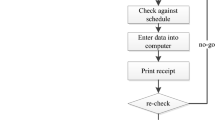Abstract
In the majority of small and medium sized enterprises (SEMs), the direct costs of material handling cannot be clearly measured. There are several reasons for this, including the large number of product types, complexity of their production cycle, and continuous change in markets. Therefore, production managers require flexible tools to create a suitable material handling system model which explicitly and rapidly calculates the indices required as these are traditionally neglected or laboriously approximated, (i.e., time and cost in material flow inside the factory, storage area requirements, and MH utilization percentage). This paper proposes an integrated approach to analyzing and controlling material handling operations in an industrial manufacturing plant from a “full quantitative” point of view. The model presented unites quite different fields of research into a unique methodology. This material handling model rapidly and automatically provides production managers with extensive and significant information. As a result, integrated layout flow analysis interrelates systematic layout planning with operational research algorithms and visual interactive simulation, using a complete software platform to implement them. This integrated layout flow analysis approach focuses on determining the space requirement for manufacturing department buffers, the transportation system requirements, the performance indices, and the time and cost of material flows spent in the layout and in MH traffic jams.
Similar content being viewed by others
References
Tompkins JA, White JA, Bozer YA, Frazelle EH, Tanchoco JMA, Trevino J (2003) Facilities Planning, 3rd edn, Wiley, New York
De Almeida D, Kellert P (2000) “An analytical queuing network model for flexible manufacturing systems with discrete handling device and transfer blockings”. Int J Flex Manuf Syst 12:25–27, DOI 10.1023/A:1008171031506
Pereira J, Paulre B (2001) Flexibility in manufacturing systems: A relational and a dynamic approach. Europ J Op Res 130(1):70–82, DOI 10.1016/S0377-2217(00)00020-5
Koopmans TC, Beckman M (1957) Assignment problems and the location of economic activities. Econometrica 25:53–76, DOI 10.2307/1907742
Kusiak A, Heragu SS (1987) “The facility layout problem”. Europ J Op Res 29:229–251, DOI 10.1016/0377-2217(87)90238-4
Heragu SS, Kusiak A (1991) Efficient models for the facility layout problem. Europ J Op Res 53(1):1–13, DOI 10.1016/0377-2217(91)90088-D
Heragu SS, Kusiak A (1990) Machine layout: an optimization and knowledge-based approach. Int J Prod Res 28(4):615–635, DOI 10.1080/00207549008942744
Drira A, Pierreval H, Hajri-Gabouj S (2007) Facility layout problems: A survey. Annu Rev Control 31(2):255–267
Moore JM, Lee RC (1967) “CORELAP, computerized relationship layout planning”. J Ind Eng 18:3
Seehof M, Evans WO (1967) Automated layout design program. J Ind Eng 19:690–695
Armour GC, Buffa ES (1963) A heuristic algorithm and simulation approach to relative allocation of facilities. Manag Sci 9:294–309
Yang T, Peters BA, Tu M (2005) Layout design for flexible manufacturing systems considering single-loop directional flow patterns. Europ J Op Res 164:440–455, DOI 10.1016/j.ejor.2003.04.004
Castillo I, Peters BA (2004) Integrating design and production planning considerations in multi-bay manufacturing facility layout. Europ J Op Res 157:671–687, DOI 10.1016/S0377-2217(03)00296-0
Braglia M, Zanoni S, Zavanella L (2003) Layout design in dynamic environments: Strategies and quantitative indices. Int J Prod Res 41:995–1016, DOI 10.1080/00207540210162983
Ferrari E, Pareschi A, Persona A, Regattieri A (2003) Plant layout computerized design: logistic and re-layout software (LRP). Int J Adv Manuf Tech 12:917-922
Holland HJ (1975) Adaptation in natural and artificial systems. University of Michigan Press, Ann Arbor
Hu L, Yasuda K (2006) Minimising material handing cost in cell formation with alternative processing routes by grouping genetic algorithm. Int J Prod Res 44(11):2133 - 2167, DOI 10.1080/00207540500336108
Vin E, De Lit P, Delchambre A (2005) A multiple-objective grouping genetic algorithm for the cell formation problem with alternative routings. J Intell Manuf 16(2):189–205, DOI 10.1007/s10845-004-5888-4
Brown EC, Sumichrast RT (2001) CF-GGA: A grouping genetic algorithm for the cell formation problem. Int J Prod Res 39(16):3651–3669
James TL, Brown C, Keeling KB (2007) A hybrid grouping genetic algorithm for the cell formation problem. Comp Op Res 34(7):2059–2079
Kim KS, Chung BD, Jae M (2003) A design for a tandem AGVS with multi-load AGVs. Int J Adv Manuf Technol 22:744–752, DOI 10.1007/s00170-003-1614-1
Kim KS, Jae M (2003) An object-oriented simulation and extension for tandem AGV systems. Int J Adv Manuf Technol 22:441–455, DOI 10.1007/s00170-003-1542-0
Huang C, Nof SY (1998) Development of an integrated models for material flow design and control-a tool perspective”. Robot Comp Int Manuf 14:441–454, DOI 10.1016/S0736-5845(98)00019-2
Suri R (1995) Quantitative techniques for robotic system analysis. Handbook of Industrial Robotics, Wiley, New York, pp 605–638
Muther R (1961) Systematic Layout Planning. Von Nostrand, New York
Dantzig GB (1949) “oftware of interdependent activities: II mathematical model. Econometrica. 17:200–211, DOI 10.2307/1905523
Murty KG (1976) Linear and combinatorial programming. Wiley, New York
Dijkstra EW (1959) A note on two problem in connexion with graphs. Numer Math 1:269–271, DOI 10.1007/BF01386390
Hollier RH (1987) Automated guided vehicle system. Springer, Berlin
Ferrari E, Gamberi M, Manzini R, Pareschi A, Persona A, Regattieri A (2002) Effectiveness of dynamic simulation supporting and optimising design and management of warehouse facilities, Proc Business and Industry Symposium. ASTC, San Diego, pp 76–81
Hillier FS, Liberman GJ (1980) Introduction to operational research. Holden-Day, San Francisco
Author information
Authors and Affiliations
Corresponding author
Rights and permissions
About this article
Cite this article
Gamberi, M., Manzini, R. & Regattieri, A. An new approach for the automatic analysis and control of material handling systems: integrated layout flow analysis (ILFA). Int J Adv Manuf Technol 41, 156–167 (2009). https://doi.org/10.1007/s00170-008-1466-9
Received:
Accepted:
Published:
Issue Date:
DOI: https://doi.org/10.1007/s00170-008-1466-9




